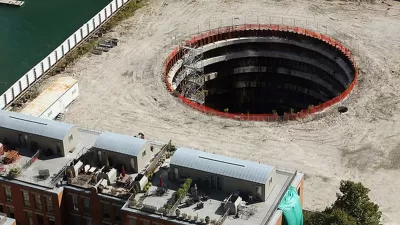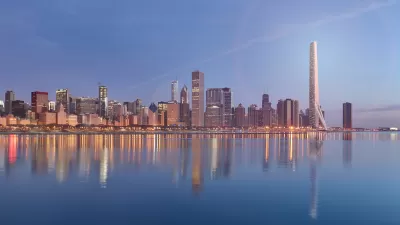The high-water marks showing where the last boom broke under the pressure of the Great Recession are still visible in cities all over the country. The Chicago Tribune recently checked on a particularly poignant example in Chicago.

Kim Janssen checks in on the hole in the ground that almost became the Chicago Spire skyscraper, and the second-tallest building in the world after the Burj Khalifa.
After the Great Recession forced Spire developer Garrett Kelleher to halt construction with only a 76-foot-deep hole that would have been the building's foundation to show, the property has since changed hands and not much else.
Janssen reports, however, that "[w]orkers last week started moving dirt to form a landscaped berm that will block the view of the 110-foot diameter hole from a row of 10 Streeterville row homes on the 400 block of East Water Street." The camouflage effort was followed by a communication from current owners the Related Midwest announcing, in effect, that there's nothing to see, or expect, at the Spire.
FULL STORY: After 2,000-foot dream dashed, Chicago Spire's remains to be hidden behind dirt mound

Trump Administration Could Effectively End Housing Voucher Program
Federal officials are eyeing major cuts to the Section 8 program that helps millions of low-income households pay rent.

Planetizen Federal Action Tracker
A weekly monitor of how Trump’s orders and actions are impacting planners and planning in America.

Ken Jennings Launches Transit Web Series
The Jeopardy champ wants you to ride public transit.

Washington Legislature Passes Rent Increase Cap
A bill that caps rent increases at 7 percent plus inflation is headed to the governor’s desk.

From Planning to Action: How LA County Is Rethinking Climate Resilience
Chief Sustainability Officer Rita Kampalath outlines the County’s shift from planning to implementation in its climate resilience efforts, emphasizing cross-departmental coordination, updated recovery strategies, and the need for flexible funding.

New Mexico Aging Department Commits to Helping Seniors Age ‘In Place’ and ‘Autonomously’ in New Draft Plan
As New Mexico’s population of seniors continues to grow, the state’s aging department is proposing expanded initiatives to help seniors maintain their autonomy while also supporting family caregivers.
Urban Design for Planners 1: Software Tools
This six-course series explores essential urban design concepts using open source software and equips planners with the tools they need to participate fully in the urban design process.
Planning for Universal Design
Learn the tools for implementing Universal Design in planning regulations.
Heyer Gruel & Associates PA
Ada County Highway District
Institute for Housing and Urban Development Studies (IHS)
City of Grandview
Harvard GSD Executive Education
Toledo-Lucas County Plan Commissions
Salt Lake City
NYU Wagner Graduate School of Public Service




























